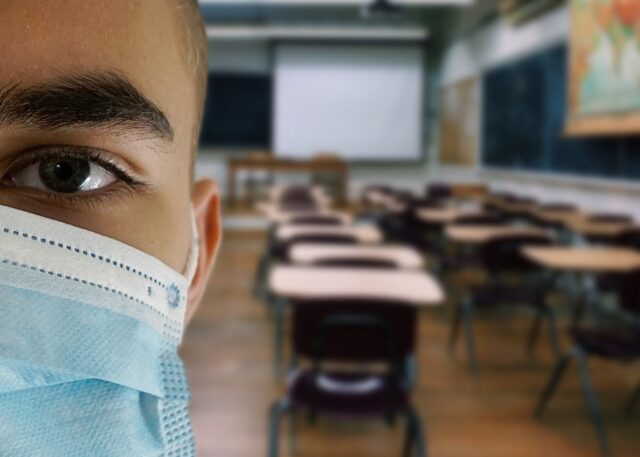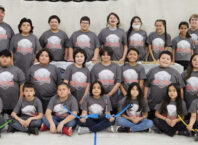By Lee Egerstrom
A Native American mother who is also a Minneapolis librarian says there a lots of lessons to be learned about teaching children as communities, school districts, public libraries and families sort through what worked in teaching children during the COVID-19 pandemic.
“It isn’t easy for some students to work on an iPad (tablet) for seven-and-a-halve hours a day,” said Allison Waukau, describing the challenge students have with using technology for distance learning. And other students, who for various reasons are less comfortable in group settings, such as classrooms, excel under more isolated circumstances, she said.
Waukau, a Menominee enrolled member and Navajo, has a son in kindergarten who has been in a distance learning class. “I do enjoy the time with him, but this doesn’t work for every family.”
She also works most of the time online herself at Franklin Library, 1314 E. Franklin Ave., where she helps people with life-long education, education preparation and cultural learning for Native Americans and immigrants in the Phillips Neighborhood.
Her assessment of distance learning and distance work is timely. Students all across Minnesota are returning to classrooms in counties where the coronavirus infection rates have dropped to perceived safe levels and as vaccination rates rise.
As March gave way to April and the start of the last two months of the current school year, more than 1 million Minnesotans were fully vaccinated, the Minnesota Health Department officials reported. State officials were hoping that half the state’s population would be vaccinated by end of April and have lowered access to vaccines to everyone 16 and older.
After a spring break, Minneapolis middle school and high school students will begin returning to in-class studies on April 12. This already happened in other Minnesota school districts; all offer online, or distance learning options, where family health concerns, quarantines from exposures, or personal choices make this learning experience preferable.
Clearly, the old educational metaphor “one size doesn’t fit all” applies to efforts such as distance learning, in-class learning and “hybrid” class systems schools employed in the past year.
Minneapolis Public Schools has always had online options, said Braden Canfield, a social worker with the Indian Education Department for the schools. This has been helpful for students with anxiety problems and other issues.
While they shouldn’t rely on this fully to address their fears, “I cannot imagine that the positive lessons of this recent experiment in distance learning will go to waste,” he said.
Despite stories about students struggling with distance learning, Canfield said, “there are many others of Native students who were not doing well in school (now) shining in this venue.
“This is a time to feel hopeful and get creative,” he said.
There are a large group of people, and their supportive organizations, creatively working to assist and inspire Native students in Minneapolis to stay in school and continue their learning. A particularly informative article, “Affirming Native Student Attendance in Minneapolis,” by Drake Lawrence was published March 9 by the Humphrey School at the University of Minnesota.
Lawrence reviews the collaborative work by the Division of Indian Work, Hennepin County be@school, Little Earth of United Tribes, Metropolitan Urban Indian Directors (MUID), Migizi Communications, Minneapolis Public Schools and its Indian Education Department, the Phillips Indian Educators and Hennepin County Library.
Community Liaison Waukau knows firsthand how the county-city library system fits into the picture. The Franklin Library, on the American Indian Cultural Corridor in south Minneapolis, has long been an adjunct for Native American students’ education.
Libraries have been impacted by the coronavirus like everywhere else, she said. Franklin, being a smaller size neighborhood library, has restricted hours for browsing and for using computers and technology important for student studies and research.
This makes it important for students and community members to check with their neighborhood or preferred library for when space, technical equipment and tutors for homework may be available.
The Franklin Learning Center, which has volunteers and librarians to help community members with a variety of learning needs, and the Franklin Teen Center have support staff to help with technology classes and academic support.
Also sharing space in the library is the Phillips Technology Center that provides free computer training and access to technology, supported by groups such as the Minnesota Indian Women’s Resource Center, Project for Pride in Living, Waite House and the Franklin Library.
“All teens can get help with homework at Franklin,” the library stresses on its website
Limiting access into the library has meant Waukau, like many if not most working mothers in Minnesota, has done a lot of her work from home. This, she said in an interview, has given her more enjoyable time at home with her son while he has been in distance learning.
It has also given her time and perspectives on how work and education have changed during the COVID restraints on activities. Like Minneapolis schools’ Canfield, she is confident there is a “silver lining” in what parents, students and educators may be learning.
Waukau said she “stumbled” across a television network feature the last weekend of March that showed how distance learning and distance work are changing life in America. Part of that, she said, is the “rediscovery of ‘old ways’ that were always important in the lives of Indigenous people.
Where and when weather permits, she said, teachers were taking students outside and were using technology to teach everything from math to environmental science studies. “That was always our culture,” she said.
With technology now being used in schools, and in distance learning, you can now bring experts and speakers, “such as Pueblo pottery makers, right into the class – inside or out,” she said.
“It will be interesting to see how educators incorporate these learning opportunities going forward.”
Distance learning and return to in-class learning in Mpls Public Schools https://sites.google.com/mpls.k12.mn.us/2020-21
Minnesota Department of Health and Minnesota Department of Human Services sites on COVID-19 and schools across the state can be found at www.health.state.mn.us/diseases/coronavirus/schools/index.html, and www.health.state.mn.us/diseases/coronavirus/situation.html
Info on new federal funding that will help families and Native students is at https://mn.gov/dhs/media/news/#/detail/appId/1/id/473317.
The Lawrence report on Minneapolis Native students can be found at www.hhh.umn.edu/news/affirming-native-student-attendance-minneapolis.







